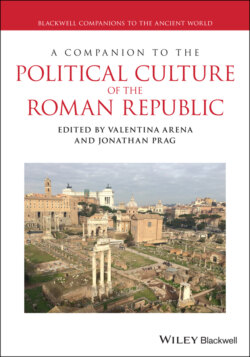Читать книгу A Companion to the Political Culture of the Roman Republic - Группа авторов - Страница 59
5.2 Classical Conditioning
ОглавлениеThe generation of American revolutionaries found the classics so appealing because they perceived the ancient republics as the origin and embodiment of some of the most powerful ideals they cherished, namely the ideological bundle modern scholarship understood under the common framework of ‘the republican synthesis’ (see Shalhope 1972; 1982; cf. Chapter 28). Indeed, many revolutionaries envisioned a society and government based on virtue and disinterested citizenship, the main sources of classical republicanism (Fink 1962; Pocock 1975 (2003)). Unsurprisingly, a powerful ideal of many of the Revolution’s leaders and their followers was not a democracy (a government still associated with the rule of the mob), but rather an organic hierarchy led by patricians who would embody the classical virtues (Adams 2001). It is thus Republican Rome more than any other classical polity that dominated their historical and political imaginations and it was Rome that revolutionaries ‘saw as the noblest achievement of free men aspiring to govern themselves’ (Schlesinger 1986: 5). It was Rome, not a Greek polis, that appealed to the republican political sensibilities of patriots and thus it was Rome that they envisioned while erecting their own republic on western shores.1
The world of classical antiquity was becoming meaningful after 1750 to ever-growing numbers of North Americans. American elites have always been preoccupied with the classics, their formal education based on a strict and uniform curriculum that stressed Latin (and Greek and Hebrew to a lesser extent), derived from the admission requirements of contemporary colleges, of which there were nine in 1776 and 25 by 1800. Students graduating from grammar school would be expected to read Cicero and Virgil in Latin, and the New Testament in Greek, if they wished to be admitted to college. The years spent in college deepened the familiarity of generations of Americans with antiquity and its languages (Cremin 1970). The holdings of public and private libraries reflected these cultural interests; catalogues consistently show between 10 and 12% of classical materials, both of originals and of translations (Reinhold 1984: 29). Yet even Americans who were not privileged enough to enjoy the benefit of years of rigid classical studies could still develop formidable knowledge and a sense of familiarity with the world of antiquity. Men such as George Washington and Patrick Henry never learned Latin; nonetheless, they and many of their like were able to make Rome and its history meaningful to their private and public lives to a remarkable degree.
Late eighteenth-century reading Americans developed a ‘vernacular classical’ canon of modern histories of antiquity and translations from the Latin and Greek; that category ‘was rapidly encroaching on the cultural reverence for ancient texts in Greek and Latin’ (Winterer 2001: 26). Obviously, such ‘vernacular classicism’ vastly extended the potential number of participants in the classical discourse to Americans who could read English but were not proficient in Latin or Greek. Additionally, a classical visual culture emerged during those decades, through which they were introduced to classical pictorial representations and symbolisms by way of paintings, broadsides, coins, paper currency, seals, almanacs, magazines, bowls, banners, wallpaper, furniture and fashion (Winterer 2005). The venues in which they were bombarded with classical themes expanded as well and by the late eighteenth century included salons, coffee-houses, literary societies and clubs, theatres and public orations (see Shields 2000). The rise of such discursive institutions converged with the permeation of antique forms into the sphere of art, architecture and nomenclature. Indeed, historians of the classical tradition in America seem to agree that the novel oral, visual and printed modes of communication in early America ‘broadly diffused’ the classical tradition in late eighteenth-century America, a tradition which, by the last quarter of the eighteenth century, had a ‘palpable presence’ (Winterer 2004: 29). When imperial tensions began escalating after the mid-1760s, this widespread and ever growing familiarity with classical antiquity could be quickly transformed into an overtly political and most effective revolutionary language.
